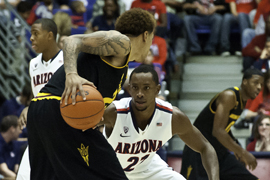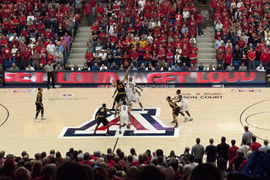Cronkite News has moved to a new home at cronkitenews.azpbs.org. Use this site to search archives from 2011 to May 2015. You can search the new site for current stories.
They faltered on the court, but Arizona’s college teams gained in the classroom
WASHINGTON – It’s been a disappointing year all around for college basketball in Arizona.
None of the state’s three Division I schools qualified to dance in the men’s or women’s NCAA basketball tournament, leaving Arizona without a team to root for during March Madness.
But while their on-court performance hasn’t measured up, the teams have posted small off-court gains in academic ratings in recent years, according to a report by the Institute for Diversity and Ethics in Sport at the University of Central Florida.
The improvements come as the NCAA is toughening academic requirements for teams to remain eligible for postseason play.
Every one of Arizona’s teams currently meets the Academic Progress Rate of 930 or more that will be needed to play in the NCAA tournament. That’s more than can be said for 13 of the men’s teams in this year’s tournament, including such marquee basketball schools as Indiana, Syracuse and Connecticut, last year’s national champion.
Only three women’s teams in this year’s tournament fell below 930.
The Academic Progress Rate is a four-year average of academic performance, incorporating graduation rates and factoring in such things as players who leave early for the pros but were on track to graduate.
A 930 APR roughly translates to a 50 percent on-track graduation rate. The new benchmark for post-season play is being phased in gradually by the NCAA and will fully take effect in the 2015-16 academic year.
The improvement by Arizona’s schools reflects a slight national trend, said Richard Lapchick, the author of the University of Central Florida report.
U.S. Secretary of Education Arne Duncan said he was encouraged by Lapchick’s findings, but reminded schools lagging behind that they risk ineligibility.
“I’m confident that you’ll see dramatic improvements in their Academic Progress Rates in the coming years,” Duncan said during a phone conference announcing the findings this week. “If they don’t improve, you just simply won’t see them in the tournament.”
Last year, the University of Arizona’s men made the tournament with a graduation success rate of just 20 percent – the lowest of any team in the 2011 tournament. Despite that, the Wildcats had a 944 APR last year.
But the latest graduation number more than doubled, to 43 percent, and the APR ticked up six points to 950.
The Wildcat women posted an APR of 932 this year, closest of any Arizona school to the cutoff.
Arizona State’s men last went to the NCAA tournament in 2009, when the team had a 905 APR and a 38 percent graduation success rate. Those numbers have since climbed to 961 and 56, respectively.
The Sun Devils women have declined slightly since their March Madness appearance last year, when the team APR was at 974, three points higher than this year’s 971.
The report also revealed a large disparity in graduation rates continues to exist between black and white players. More than half the teams in the men’s tournament posted white graduation success rates that were at least 30 percentage points higher than those for black players.
At University of Arizona, the gap is 75 percentage points for the men’s team and 36 points for the women.
“The issue of race remains the most prominent issue in the graduate rate studies that we release every year,” Lapchick said. “And it’s not just the issue of race for our student athletes but in general on our college campuses.”
Calls seeking comment from athletic departments at Arizona State and Arizona were not returned Friday.








